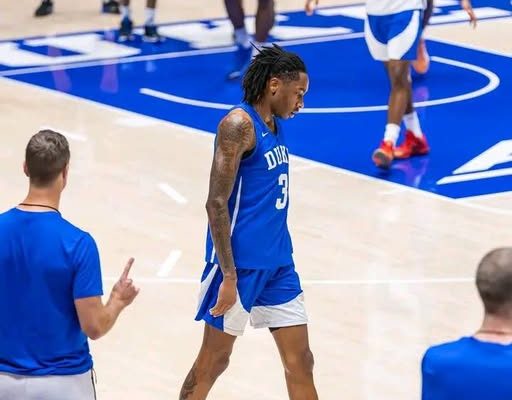The basketball world often fixates on headline-grabbing signings, five-star recruit commitments, or viral slam dunks in open gym runs. But occasionally, the most transformative decisions happen far from the spotlight—quiet, calculated, and rooted in self-awareness. That’s precisely what unfolded recently within the walls of Cameron Indoor Stadium. This summer, Duke basketball didn’t just train harder or add another big-name player; it made an adjustment so fundamental that insiders are calling it “the smartest move yet” of the Jon Scheyer era. It wasn’t about flash. It wasn’t loud. But it might just be the quiet catalyst that shifts Duke from being a mere tournament team to a legitimate national championship contender.
Word out of Durham has it that a single change in summer practice routines—one tied directly to leadership delegation and tempo management—has had a cascading effect on everything from team chemistry to execution. Though specifics are being guarded tightly, reports from close observers, former players, and staff suggest that the team’s new rotational philosophy has upended how the Blue Devils approach preparation. Instead of relying on pure talent to dictate rhythm, the coaching staff has altered how practice sessions are run. There’s more player input. There’s more situational simulation. And above all, there’s a heightened focus on defensive accountability—something that had at times looked shaky in recent tournament runs.
To understand why this is such a monumental shift, you need to revisit the past two seasons under Scheyer. In both years, Duke was undeniably talented. They had the five-stars, the NBA lottery picks, and the depth to compete with anyone. But when it came to March, they never quite clicked the way fans hoped. There was a nagging sense that Duke lacked a unifying thread on the court—someone or something to bind the talent together into a cohesive whole. Critics questioned rotations, team identity, and clutch-time decision-making. While Scheyer never lost the locker room, there was always this ambient pressure: to prove that Duke’s dynasty didn’t retire with Coach K.
So this summer, instead of doing what many would expect—going bigger, louder, or more aggressive—Scheyer and his staff pivoted in the opposite direction. Practices were redesigned from the ground up. Roles, particularly at the guard and forward positions, were reassessed based not just on athletic upside but on in-game IQ and vocal leadership. Word is, certain returning players were asked to lead drills instead of assistants. Communication became the currency of competition. This fostered a level of ownership among players that coaches hadn’t fully seen since the Zion-WRJ-Reddish year. Rather than just being told what to do, this group began to anticipate and self-correct—a habit more often seen on veteran NBA squads than college teams still finding their identity.
Insiders say that the moment this shift began paying off came during a closed scrimmage where the second unit, filled with underclassmen and a few overlooked contributors, ran the starters off the floor. Not with alley-oops or flashy crossovers, but through disciplined rotations, relentless perimeter defense, and elite spacing on offense. It was a jarring wake-up call for the top recruits. It forced the more talented players to look inward and refine their decision-making. That kind of humility doesn’t come easy at a place like Duke, where most players were kings in high school and AAU. But it’s exactly the kind of trial-by-fire that forges championship resilience.
One particular veteran has reportedly emerged as the anchor of this transformation. Though not the team’s leading scorer, this guard has been described as a “floor general of a different breed.” Rather than barking orders or demanding the ball, he controls pace, encourages smarter switches, and holds teammates accountable in the huddle. “He’s like having a second coach out there,” one staffer said. “He knows when to push, when to slow it down, and when to challenge a teammate. That kind of leadership is priceless.” The ripple effect is already showing up in the team’s shot selection and assist-to-turnover ratios during scrimmage play. They’re not just playing faster; they’re playing smarter.
While many teams use the summer as a conditioning tool, Duke has gone cerebral. Strategy meetings have been extended. Film sessions have increased in frequency and detail. Players are being asked to break down opposing schemes—not just react to them. One coach described it as “teaching the chessboard, not just the chess moves.” And in a landscape where raw talent is abundant but basketball IQ remains a competitive separator, this could be the single most significant edge Duke cultivates this season.
Perhaps the most promising outcome of this change is what it’s done to the team’s defensive identity. Duke had struggled in recent years to consistently lock down elite guards and close out shooters. But with the new practice structure, defenders are being drilled with multi-positional assignments and challenged to think two plays ahead. The result? More confident help defense, better transition containment, and crisper switches. In several early scrimmages, the offense has reportedly struggled to get clean looks, a testament to how serious this group is about defense being their calling card.
This may all sound like minutiae to the casual fan, but history shows that the smallest tweaks often yield the most seismic results. Think back to Villanova’s commitment to spacing and ball movement in the mid-2010s, or Virginia’s devotion to their Pack Line defense. These weren’t trendy schemes; they were philosophies that required full buy-in and brutal repetition. That’s the road Duke appears to be traveling now—a shift away from highlight-chasing and toward habits that win championships.
It also bodes well for the development of Duke’s incoming freshmen, who are said to be responding exceptionally well to the structured environment. One coach mentioned a freshman wing who’s already earned starter consideration purely through his ability to execute defensive rotations and keep the ball moving. “He’s not the most explosive guy,” the coach said, “but he knows exactly where to be. That’s rare at this stage.” In a world where youth is often associated with chaos, Duke might just be building a freshman core that defies the stereotype.
Of course, the true test will come in the early-season non-conference schedule, where Duke is expected to face top-25 opponents in back-to-back matchups. The new system will face pressure, hostile crowds, and elite scorers looking to break it apart. But if what’s being whispered now proves durable, this Duke team could be significantly harder to rattle. In fact, one opposing scout reportedly told a colleague, “If this is how they’re going to play all year, we’re going to have to prepare like it’s March in November.”
The whispers have grown into quiet confidence in Durham. The players aren’t thumping their chests or tweeting cryptic messages. Instead, they’re showing up early to film, challenging each other in conditioning, and making decisions on the floor that mirror those of seasoned pros. In a conference that continues to evolve, with powerhouses like UNC, Miami, and Virginia Tech reloading, Duke’s edge might not be talent this year—it might be poise.
By season’s end, this subtle summer shift—this decision to redefine how the team learns, communicates, and competes—may go down as one of the pivotal moments in Duke basketball history. In a sport where a single possession can swing a Final Four bid, it’s often the smallest gears that turn the biggest wheels. And if Duke does make a run this year, don’t expect players or coaches to point to a buzzer-beater or viral dunk as the turning point. They’ll tell you it started in silence—in an unassuming gym, during a hot North Carolina summer, when a team decided to grow up and get serious.
In an era of big moves, big names, and big egos, Duke may have just proved that the smartest move is often the quietest one.


